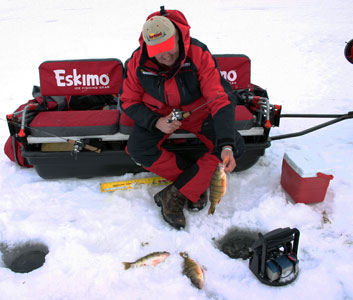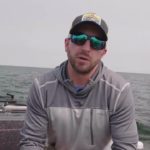Mac Daddy Perchin’
“What lake produces the largest number of giant perch?” Some of the biggest perch I’ve ever seen have come from Lake of the Woods, but the action is usually pretty spotty. Devil’s Lake in North Dakota can give up some real giants but the action there has been terribly inconsistent. Leech Lake, Winnibigoshish, and Mille Lacs on the other hand are natural borne perch factories and will give up the goods when conditions are right. Right now the conditions on Mille Lacs are better than they’ve been for years and it might be a good idea to schedule a trip to the “dead sea”. Leech is another great option and is loaded with nice perch including some real hawgs in the fifteen inch plus range. Winnie is almost always a good pick for chasing jumbo perch but the average size tends to run a little smaller than Mille Lacs or Leech.
Mirror mirror on the wall; what lake produces the biggest perch of all? A fairer question might be;
 “What lake produces the largest number of giant perch?” Some of the biggest perch I’ve ever seen have come from Lake of the Woods, but the action is usually pretty spotty. Devil’s Lake in North Dakota can give up some real giants but the action there has been terribly inconsistent. Leech Lake, Winnibigoshish, and Mille Lacs on the other hand are natural borne perch factories and will give up the goods when conditions are right. Right now the conditions on Mille Lacs are better than they’ve been for years and it might be a good idea to schedule a trip to the “dead sea”. Leech is another great option and is loaded with nice perch including some real hawgs in the fifteen inch plus range. Winnie is almost always a good pick for chasing jumbo perch but the average size tends to run a little smaller than Mille Lacs or Leech.
“What lake produces the largest number of giant perch?” Some of the biggest perch I’ve ever seen have come from Lake of the Woods, but the action is usually pretty spotty. Devil’s Lake in North Dakota can give up some real giants but the action there has been terribly inconsistent. Leech Lake, Winnibigoshish, and Mille Lacs on the other hand are natural borne perch factories and will give up the goods when conditions are right. Right now the conditions on Mille Lacs are better than they’ve been for years and it might be a good idea to schedule a trip to the “dead sea”. Leech is another great option and is loaded with nice perch including some real hawgs in the fifteen inch plus range. Winnie is almost always a good pick for chasing jumbo perch but the average size tends to run a little smaller than Mille Lacs or Leech.
Finding February perch isn’t all that difficult and is a matter of drilling some holes and covering ground. Good starting spots include deep gravel humps and mud flats on Mille Lacs, shoreline sand breaks on Leech, and offshore humps and bars on Winnie. Starting spots are just that, and may not be where you end the day. The thing is if you’re on ‘em they bite. If not; they don’t. They don’t bite and they don’t even show up on a depth finder so keep moving until you start hooking a few. And small fish aren’t the answer either and can be anywhere and everywhere. Perch school by size and if you’re catching nothing but small fries it’s time to pick up and move.
If you’re working a hump or reef; try fishing the top, the sides, or fifty yards or more off the side in deeper water. Same thing goes for the shoreline breaks. You never know where they are for sure so be prepared to cover it all. The good thing is it really doesn’t take very long to figure out if you’re barking up the wrong tree. If you’re in the right area you should see and catch fish within fifteen minutes or so. If not; time to move on and drill some more holes. A power auger is a must and where my Eskimo Shark is worth its weight in gold. The high speed engine starts with one or two pulls, keeps running, and flies through thick layers of ice without hanging up and bogging down. It makes drilling holes much easier which means you’ll drill more and up your odds for finding the mother lode.
It might also call for a snowmobile if there is too much snow. On lakes like Mille Lacs and Winnie they’re going to be roads all over and you can definitely get to productive areas but a sled and a portable house can help get you over fish that haven’t been touched and that is always an advantage. To help find those likely spots a G.P.S like the one that comes with the Humminbird Ice 55/385c is invaluable and has a chart plotter along with extra mounts that allow me to pop it into the truck, onto the sled, and back with the flasher in seconds.
One of the hottest tickets for hooking up with eye popping jumbos includes spooning, and lots of it. Smaller spoons like an eighth ounce Buck-Shot Dropper Spoon can be downright deadly and why I’m always using at least one rod rigged with a spoon. The Dropper Soon is a unique bait that has a built in rattle and a short dropper with a single colored hook that you can tip with a smaller minnow or maybe a waxie. It’s a finesse presentation that gets down the hole fast and can trigger fish that are a little bit finicky. Once you find a few fish it would be a good idea to drill a few more holes in the same area and drop down a second stationary rig. A smaller jig tipped with a small minnow and suspended below a float like Northland Tackle’s Lite-Bite Slip Bobber makes for a great set rig. The Lite-Bite has a brass eye grommet built in that allows the line to slide freely and quickly and will get you back to the biters as quickly as possible. The extra holes will help you to move with the fish which often make smaller moves this way and that and you can chase them down instead of waiting for them to come back.
When you do find fish and you have it to yourself the action can be relatively consistent and you may be able to go back time after time and keep on catching. They might be a little deeper or shallower but where you left off is a good place to get started the next time out. See you on the ice.





